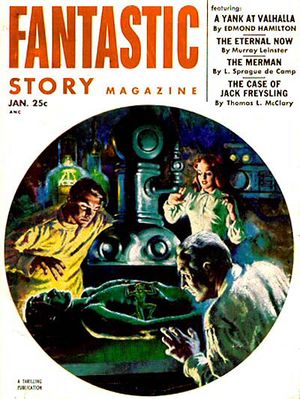Fantastic Story Magazine
Fantastic Story Magazine was a 1950-55 science fiction pulp magazine which merged pulp reprints with new stories.
It was published on a quarterly schedule by Best Books, a subsidiary imprint of Standard Magazines. Initially priced at 25 cents, the 160-page debut issue (Spring 1950) was titled Fantastic Story Quarterly, and it continued with that title for a year. Beginning with the Summer 1951 issue, it was known as Fantastic Story Magazine until it folded (Spring 1955), leaving a total of 23 issues.
Writers
Each issue featured a lead novel or novella and short stories. A. E. van Vogt's Slan was reprinted in issue #10, and Stanley G. Weinbaum's "The Black Flame" was reprinted in #9. In the first issue, Edmond Hamilton's novel "The Hidden World" was followed by "Trespass!", a short story collaboration by Poul Anderson and Gordon Dickson, plus stories by Raymond Z. Gallun, John Russell Fearn and others. The second issue included stories by James Blish and Jack Williamson, with Eando Binder in the third issue and Eric Frank Russell in the fourth, followed by Damon Knight (#5), Henry Kuttner (#6), Chad Oliver (#7), L. Sprague de Camp (#8), Sam Merwin, Jr. (#9), Daniel Keyes (#10), Fletcher Pratt (#11), Walter M. Miller, Jr. (#12), Richard Matheson (#13), H. L. Gold and Carl Jacobi (#14), Murray Leinster (#15), Philip K. Dick (#16), Manly Wade Wellman and Otis Adelbert Kline (#17), John W. Campbell, Jr. (#18), Alfred Coppel (#19), Ray Bradbury and Ray Cummings (#20), Arthur K. Barnes (#21), Jack Vance (#22) and David H. Keller (#23).
Cover design
A curved logo was used for the Fantastic Story Quarterly title, and this same logo design continued on Fantastic Story Magazine for six issues until it was discontinued with the tenth issue (Summer 1952). The magazine was recognizable in 1952-53 by an unusual and distinctive cover design which placed the illustration in a circle surrounded by a flat color. This experiment received a cover display for five issues, from the Fall 1952 issue until May 1953. It's probable that this cover concept was a nod in the direction of Flair, a 1950-51 slick magazine which received much attention because each issue had a die-cut hole in the front cover revealing an image on the first interior page.
The cover illustrators included Jack Coggins, Ed Emshwiller, Alex Schomburg and Earle K. Bergey. Illustrations by Bergey usually featured women in space helmets and bikinis or skin-tight outfits, a type of apparel that later served as the inspiration for Princess Leia's slave-girl costume in Return of The Jedi.
One issue (Fall 1954) was prominently displayed as a prop in the movie Back to the Future, showing that the character was a science fiction reader during the early 1950s.
Chat rooms • What links here • Copyright info • Contact information • Category:Root
